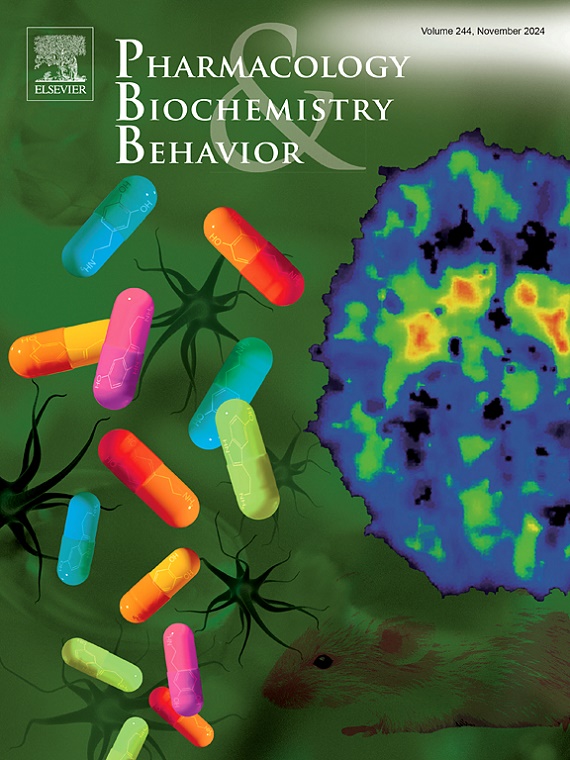(2R,6R)-羟基炔诺酮胺通过调节大鼠的 PI3K/AKT 信号通路缓解创伤后应激障碍样内型。
IF 3.3
3区 心理学
Q1 BEHAVIORAL SCIENCES
引用次数: 0
摘要
背景:被诊断为创伤后应激障碍(PTSD)的患者主要表现出持久的不良情绪,容易产生自杀念头和行为。值得注意的是,氯胺酮的代谢物,尤其是(2R,6R)-羟基氯胺酮(HNK),已被证明具有良好的抗抑郁特性。然而,HNK对创伤后应激障碍患者的负面情绪症状产生治疗作用的确切机制尚待充分阐明:在这项研究中,我们利用了一个涉及单次长时间应激和足底冲击(SPS&S)的模型,然后在恢复阶段之后向侧脑室注射(2R, 6R)-HNK。创伤后应激障碍相关行为的评估是通过开阔地试验(OFT)、高架迷宫试验(EMPT)和强迫游泳试验(FST)进行的。利用分子生物学实验分析了磷脂酰肌醇3-激酶(PI3K)/磷酸激酶B(AKT)信号通路在大鼠脑区的表达情况:结果:SPS&S大鼠表现出以抑郁和焦虑为特征的不良情绪行为。用(2R, 6R)-HNK 治疗可增强探索行为并逆转负面情绪行为。这种干预缓解了HIP和PFC中PI3K/AKT信号通路相关蛋白表达水平的紊乱,但没有影响SPS&S大鼠AMY中的PI3K/AKT信号转导:结论:创伤应激可引发大鼠的负性情绪反应,可能涉及 HIP、PFC 和 AMY 中的 PI3K/AKT 信号通路。(2R,6R)-HNK化合物已证明有可能减轻SPS&S范式下大鼠的不良情绪。这种效应可能是由于调节了 HIP 和 PFC 中的 PI3K/AKT 信号通路,在 HIP 区域观察到的影响尤为显著。本文章由计算机程序翻译,如有差异,请以英文原文为准。
(2R,6R)-hydroxynorketamine alleviates PTSD-like endophenotypes by regulating the PI3K/AKT signaling pathway in rats
Background
Patients diagnosed with post-traumatic stress disorder (PTSD) mainly exhibit enduring adverse emotions, heightening susceptibility to suicidal thoughts and behaviors. Notably, metabolites of ketamine, particularly (2R,6R)-hydroxyketamine (HNK), have demonstrated favorable antidepressant properties. However, the precise mechanism through which HNK exerts its therapeutic effects on negative emotional symptoms in PTSD patients should be fully elucidated.
Methods
In this investigation, a model involving a single prolonged stress and plantar shock (SPS&S) was utilized, followed by the administration of (2R, 6R)-HNK into the lateral ventricle subsequent to the recovery phase. The evaluation of PTSD-related behaviors was conducted through the open field test (OFT), elevated plus maze test (EMPT), and forced swim test (FST). The expression of phosphatidylinositol 3-kinase (PI3K)/phosphokinase B (AKT) signaling pathway in rat brain regions was analyzed using molecular biology experiments.
Results
SPS&S rats displayed adverse emotional behaviors characterized by depression and anxiety. Treatment with (2R, 6R)-HNK enhanced exploratory behavior and reversed negative emotional behaviors. This intervention mitigated disruptions in the expression levels of PI3K/AKT signaling pathway-associated proteins in the HIP and PFC, without influencing PI3K/AKT signaling in the AMY of SPS&S rats.
Conclusion
Traumatic stress can trigger negative emotional reactions in rats, potentially involving the PI3K/AKT signaling pathway in the HIP, PFC, and AMY. The (2R, 6R)-HNK compounds have demonstrated the potential to mitigate adverse emotions in rats subjected to the SPS&S paradigm. This effect may be attributed to the modulation of the PI3K/AKT signaling pathway in the HIP, and PFC, with a particularly notable impact observed in the HIP region.
求助全文
通过发布文献求助,成功后即可免费获取论文全文。
去求助
来源期刊
CiteScore
6.40
自引率
2.80%
发文量
122
审稿时长
38 days
期刊介绍:
Pharmacology Biochemistry & Behavior publishes original reports in the areas of pharmacology and biochemistry in which the primary emphasis and theoretical context are behavioral. Contributions may involve clinical, preclinical, or basic research. Purely biochemical or toxicology studies will not be published. Papers describing the behavioral effects of novel drugs in models of psychiatric, neurological and cognitive disorders, and central pain must include a positive control unless the paper is on a disease where such a drug is not available yet. Papers focusing on physiological processes (e.g., peripheral pain mechanisms, body temperature regulation, seizure activity) are not accepted as we would like to retain the focus of Pharmacology Biochemistry & Behavior on behavior and its interaction with the biochemistry and neurochemistry of the central nervous system. Papers describing the effects of plant materials are generally not considered, unless the active ingredients are studied, the extraction method is well described, the doses tested are known, and clear and definite experimental evidence on the mechanism of action of the active ingredients is provided.

 求助内容:
求助内容: 应助结果提醒方式:
应助结果提醒方式:


